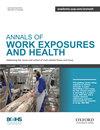133 Elevating worker health: safeguarding against reprotoxic substances exposure
IF 1.8
4区 医学
Q3 PUBLIC, ENVIRONMENTAL & OCCUPATIONAL HEALTH
引用次数: 0
Abstract
The environmental contributors to reproductive health begin in utero and include the social, physical and nutritional environment, and physical and chemical agents. In the past 70 years, there has been a dramatic increase in human exposure to both natural and synthetic chemicals. Endocrine disruptors are chemicals that may interfere with the hormonal system and thereby produce harmful effects in both humans and wildlife. Under the European REACH regulation, endocrine disruptors are identified as substances of very high concern alongside chemicals known to cause cancer, mutations and toxicity to reproduction. Similarly to carcinogens or mutagens, reprotoxic substances may have serious and irreversible effects also on workers’ health. Therefore, occupational exposure to reprotoxic substances should also be regulated under the same directive on the protection of workers from carcinogens or mutagens at work (Directive 2004/37/EC). Occupational exposure limit values have been set for 12 widely used substances in the new directive 2022/431/EC, and therefore validated exposure assessment methods should be made available. The health surveillance is requested for workers exposed to these substances, that is the assessment of the health status of an individual worker based on exposure to specific substances during work. Therefore, cooperation with obstetrician, gynaecologist and other reproductive health professionals is needed, for the assessment of male and female fertility status. On the other side clinicians should always ask women of childbearing age about occupational exposures as legal exposure limits for most workplace chemicals are not designed to protect against harm to a pregnancy or the developing fetus.133 提高工人健康水平:防止接触生殖毒性物质
影响生殖健康的环境因素始于子宫内,包括社会、物理和营养环境以及物理和化学制剂。在过去的 70 年中,人类接触天然和合成化学品的机会急剧增加。内分泌干扰物是指可能干扰荷尔蒙系统,从而对人类和野生动物产生有害影响的化学品。根据欧洲 REACH 法规,内分泌干扰素被确定为高度关注物质,与已知会导致癌症、突变和生殖毒性的化学品并列。与致癌物质或诱变剂类似,生殖毒性物质也可能对工人的健康造成严重和不可逆转的影响。因此,生殖毒性物质的职业接触也应受到关于保护工人在工作中不受致癌物质或诱变剂影响的指令(指令 2004/37/EC)的管制。新指令 2022/431/EC 为 12 种广泛使用的物质设定了职业接触限值,因此应提供有效的接触评估方法。要求对接触这些物质的工人进行健康监测,即根据工作期间接触特定物质的情况,对工人个人的健康状况进行评估。因此,需要与产科医生、妇科医生和其他生殖健康专业人员合作,对男性和女性的生育状况进行评估。另一方面,临床医生应经常询问育龄妇女有关职业接触的情况,因为大多数工作场所化学品的法定接触限值并不是为了防止对妊娠或发育中的胎儿造成伤害而设计的。
本文章由计算机程序翻译,如有差异,请以英文原文为准。
求助全文
约1分钟内获得全文
求助全文
来源期刊

Annals Of Work Exposures and Health
Medicine-Public Health, Environmental and Occupational Health
CiteScore
4.60
自引率
19.20%
发文量
79
期刊介绍:
About the Journal
Annals of Work Exposures and Health is dedicated to presenting advances in exposure science supporting the recognition, quantification, and control of exposures at work, and epidemiological studies on their effects on human health and well-being. A key question we apply to submission is, "Is this paper going to help readers better understand, quantify, and control conditions at work that adversely or positively affect health and well-being?"
We are interested in high quality scientific research addressing:
the quantification of work exposures, including chemical, biological, physical, biomechanical, and psychosocial, and the elements of work organization giving rise to such exposures;
the relationship between these exposures and the acute and chronic health consequences for those exposed and their families and communities;
populations at special risk of work-related exposures including women, under-represented minorities, immigrants, and other vulnerable groups such as temporary, contingent and informal sector workers;
the effectiveness of interventions addressing exposure and risk including production technologies, work process engineering, and personal protective systems;
policies and management approaches to reduce risk and improve health and well-being among workers, their families or communities;
methodologies and mechanisms that underlie the quantification and/or control of exposure and risk.
There is heavy pressure on space in the journal, and the above interests mean that we do not usually publish papers that simply report local conditions without generalizable results. We are also unlikely to publish reports on human health and well-being without information on the work exposure characteristics giving rise to the effects. We particularly welcome contributions from scientists based in, or addressing conditions in, developing economies that fall within the above scope.
 求助内容:
求助内容: 应助结果提醒方式:
应助结果提醒方式:


